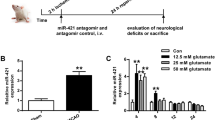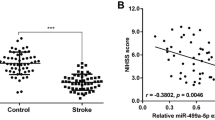Abstract
We previously observed that microRNA miR-106b-5p significantly increased in serum of patients with acute ischemic stroke. The present study was to determine whether miR-106b-5p antagomir can protect against cerebral ischemia/reperfusion (I/R) injury and elucidate its underlying mechanisms. Middle cerebral artery occlusion (MCAO) was operated on male Sprague Dawley rats. MiR-106b-5p antagomir significantly decreased neurological deficit scores, infarct volumes, and neuronal injury. Furthermore, miR-106b-5p antagomir markedly reduced malondialdehyde (MDA) content, restored superoxide dismutase (SOD) activity, increased the expression of myeloid cell leukemia-1 (Mcl-1) and B cell lymphoma-2 (Bcl-2), and decreased the expression of Bax in the ischemic cortex. In PC12 cells, miR-106b-5p inhibitor increased the Mcl-1 and Bcl-2 expression, which provided protection against glutamate-induced apoptosis and oxidative damage, as evidenced by decreased lactate dehydrogenase (LDH) release, and enhanced SOD activity. Notably, luciferase reported assay proved Mcl-1 was the target gene of miR-106b-5p. In conclusion, our data indicates that the neuroprotective effects of miR-106b-5p antagomir on cerebral I/R injury are associated with its inhibition of apoptosis and oxidative stress, suggesting a potential therapeutic target for ischemic stroke.













Similar content being viewed by others
Abbreviations
- MiRNA:
-
MicroRNA
- MCAO:
-
Middle cerebral artery occlusion
- CNS:
-
Central nerve system
- IS:
-
Ischemic stroke
- I/R:
-
Ischemia/reperfusion
- MDA:
-
Malondialdehyde
- Bcl-2:
-
B cell lymphoma-2
- LDH:
-
Lactate dehydrogenase
- SOD:
-
Superoxide dismutase
- ROS:
-
Reactive oxygen species
- TTC:
-
2,3,5-Triphenyltetrazolium chloride
- HE:
-
Hematoxylin and eosin
- MRI:
-
Magnetic resonance imaging
- FITC:
-
Fluorescein isothiocyanate
- ROS:
-
Reactive oxygen species
- 3′-UTR:
-
3′-Untranslated region
- MCM7:
-
Mini chromosome maintenance protein 7
- SEM:
-
Standard error of the mean
- PI:
-
Propidium iodide
References
Goldstein LB, Adams R, Becker K, Furberg CD, Gorelick PB, Hademenos G, Hill M, Howard G, Howard VJ, Jacobs B, Levine SR, Mosca L, Sacco RL, Sherman DG, Wolf PA, del Zoppo GJ (2001) Primary prevention of ischemic stroke: a statement for healthcare professionals from the Stroke Council of the American Heart Association. Stroke 32(1):280–299
Broughton BR, Reutens DC, Sobey CG (2009) Apoptotic mechanisms after cerebral ischemia. Stroke 40(5):e331–e339. doi:10.1161/STROKEAHA.108.531632
Lagos-Quintana M, Rauhut R, Lendeckel W, Tuschl T (2001) Identification of novel genes coding for small expressed RNAs. Science 294(5543):853–858. doi:10.1126/science.1064921
He L, Hannon GJ (2004) MicroRNAs: small RNAs with a big role in gene regulation. Nat Rev Genet 5(7):522–531. doi:10.1038/nrg1379
Im HI, Kenny PJ (2012) MicroRNAs in neuronal function and dysfunction. Trends Neurosci 35(5):325–334. doi:10.1016/j.tins.2012.01.004
Schratt GM, Tuebing F, Nigh EA, Kane CG, Sabatini ME, Kiebler M, Greenberg ME (2006) A brain-specific microRNA regulates dendritic spine development. Nature 439(7074):283–289. doi:10.1038/nature04367
Lee ST, Chu K, Jung KH, Yoon HJ, Jeon D, Kang KM, Park KH, Bae EK, Kim M, Lee SK, Roh JK (2010) MicroRNAs induced during ischemic preconditioning. Stroke 41(8):1646–1651. doi:10.1161/STROKEAHA.110.579649
Jeyaseelan K, Lim KY, Armugam A (2008) MicroRNA expression in the blood and brain of rats subjected to transient focal ischemia by middle cerebral artery occlusion. Stroke 39(3):959–966. doi:10.1161/STROKEAHA.107.500736
Liu DZ, Tian Y, Ander BP, Xu H, Stamova BS, Zhan X, Turner RJ, Jickling G, Sharp FR (2010) Brain and blood microRNA expression profiling of ischemic stroke, intracerebral hemorrhage, and kainate seizures. J Cereb Blood Flow Metab 30(1):92–101. doi:10.1038/jcbfm.2009.186
Li P, Teng F, Gao F, Zhang M, Wu J, Zhang C (2015) Identification of circulating microRNAs as potential biomarkers for detecting acute ischemic stroke. Cell Mol Neurobiol 35(3):433–447. doi:10.1007/s10571-014-0139-5
Landais S, Landry S, Legault P, Rassart E (2007) Oncogenic potential of the miR-106-363 cluster and its implication in human T-cell leukemia. Cancer Res 67(12):5699–5707. doi:10.1158/0008-5472.CAN-06-4478
Liu F, Gong J, Huang W, Wang Z, Wang M, Yang J, Wu C, Wu Z, Han B (2014) MicroRNA-106b-5p boosts glioma tumorigensis by targeting multiple tumor suppressor genes. Oncogene 33(40):4813–4822. doi:10.1038/onc.2013.428
Xiang W, He J, Huang C, Chen L, Tao D, Wu X, Wang M, Luo G, Xiao X, Zeng F, Jiang G (2015) miR-106b-5p targets tumor suppressor gene SETD2 to inactive its function in clear cell renal cell carcinoma. Oncotarget 6(6):4066–4079
Wang J, Yu JT, Tan L, Tian Y, Ma J, Tan CC, Wang HF, Liu Y, Tan MS, Jiang T, Tan L (2015) Genome-wide circulating microRNA expression profiling indicates biomarkers for epilepsy. Sci Rep 5:9522. doi:10.1038/srep09522
Shiotani A, Murao T, Kimura Y, Matsumoto H, Kamada T, Kusunoki H, Inoue K, Uedo N, Iishi H, Haruma K (2013) Identification of serum miRNAs as novel non-invasive biomarkers for detection of high risk for early gastric cancer. Br J Cancer 109(9):2323–2330. doi:10.1038/bjc.2013.596
Baraniskin A, Kuhnhenn J, Schlegel U, Chan A, Deckert M, Gold R, Maghnouj A, Zollner H, Reinacher-Schick A, Schmiegel W, Hahn SA, Schroers R (2011) Identification of microRNAs in the cerebrospinal fluid as marker for primary diffuse large B-cell lymphoma of the central nervous system. Blood 117(11):3140–3146. doi:10.1182/blood-2010-09-308684
Doeppner TR, Doehring M, Bretschneider E, Zechariah A, Kaltwasser B, Muller B, Koch JC, Bahr M, Hermann DM, Michel U (2013) MicroRNA-124 protects against focal cerebral ischemia via mechanisms involving Usp14-dependent REST degradation. Acta Neuropathol 126(2):251–265. doi:10.1007/s00401-013-1142-5
Stary CM, Xu L, Sun X, Ouyang YB, White RE, Leong J, Li J, Xiong X, Giffard RG (2015) MicroRNA-200c contributes to injury from transient focal cerebral ischemia by targeting Reelin. Stroke 46(2):551–556. doi:10.1161/STROKEAHA.114.007041
Moon JM, Xu L, Giffard RG (2013) Inhibition of microRNA-181 reduces forebrain ischemia-induced neuronal loss. J Cereb Blood Flow Metab 33(12):1976–1982. doi:10.1038/jcbfm.2013.157
Yin KJ, Deng Z, Huang H, Hamblin M, Xie C, Zhang J, Chen YE (2010) miR-497 regulates neuronal death in mouse brain after transient focal cerebral ischemia. Neurobiol Dis 38(1):17–26. doi:10.1016/j.nbd.2009.12.021
Khanna S, Rink C, Ghoorkhanian R, Gnyawali S, Heigel M, Wijesinghe DS, Chalfant CE, Chan YC, Banerjee J, Huang Y, Roy S, Sen CK (2013) Loss of miR-29b following acute ischemic stroke contributes to neural cell death and infarct size. J Cereb Blood Flow Metab 33(8):1197–1206. doi:10.1038/jcbfm.2013.68
Liu P, Zhao H, Wang R, Wang P, Tao Z, Gao L, Yan F, Liu X, Yu S, Ji X, Luo Y (2015) MicroRNA-424 protects against focal cerebral ischemia and reperfusion injury in mice by suppressing oxidative stress. Stroke 46(2):513–519. doi:10.1161/STROKEAHA.114.007482
Longa EZ, Weinstein PR, Carlson S, Cummins R (1989) Reversible middle cerebral artery occlusion without craniectomy in rats. Stroke 20(1):84–91
Brait VH, Jackman KA, Walduck AK, Selemidis S, Diep H, Mast AE, Guida E, Broughton BR, Drummond GR, Sobey CG (2010) Mechanisms contributing to cerebral infarct size after stroke: gender, reperfusion, T lymphocytes, and Nox2-derived superoxide. J Cereb Blood Flow Metab 30(7):1306–1317. doi:10.1038/jcbfm.2010.14
Yang Y, Shuaib A, Li Q (1998) Quantification of infarct size on focal cerebral ischemia model of rats using a simple and economical method. J Neurosci Methods 84(1-2):9–16
Sun L, Jin Y, Dong L, Sumi R, Jahan R, Li Z (2013) The neuroprotective effects of Coccomyxa gloeobotrydiformis on the ischemic stroke in a rat model. Int J Biol Sci 9(8):811–817. doi:10.7150/ijbs.6734
Jie P, Hong Z, Tian Y, Li Y, Lin L, Zhou L, Du Y, Chen L, Chen L (2015) Activation of transient receptor potential vanilloid 4 induces apoptosis in hippocampus through downregulating PI3K/Akt and upregulating p38 MAPK signaling pathways. Cell Death Dis 6:e1775. doi:10.1038/cddis.2015.146
Chen W, Xu B, Xiao A, Liu L, Fang X, Liu R, Turlova E, Barszczyk A, Zhong X, Sun CL, Britto LR, Feng ZP, Sun HS (2015) TRPM7 inhibitor carvacrol protects brain from neonatal hypoxic-ischemic injury. Mol Brain 8:11. doi:10.1186/s13041-015-0102-5
Chen J, Simon RP, Nagayama T, Zhu R, Loeffert JE, Watkins SC, Graham SH (2000) Suppression of endogenous bcl-2 expression by antisense treatment exacerbates ischemic neuronal death. J Cereb Blood Flow Metab 20(7):1033–1039. doi:10.1097/00004647-200007000-00002
Shimizu S, Nagayama T, Jin KL, Zhu L, Loeffert JE, Watkins SC, Graham SH, Simon RP (2001) bcl-2 Antisense treatment prevents induction of tolerance to focal ischemia in the rat brain. J Cereb Blood Flow Metab 21(3):233–243. doi:10.1097/00004647-200103000-00007
Allen CL, Bayraktutan U (2009) Oxidative stress and its role in the pathogenesis of ischaemic stroke. Int J Stroke 4(6):461–470. doi:10.1111/j.1747-4949.2009.00387.x
Chen H, Yoshioka H, Kim GS, Jung JE, Okami N, Sakata H, Maier CM, Narasimhan P, Goeders CE, Chan PH (2011) Oxidative stress in ischemic brain damage: mechanisms of cell death and potential molecular targets for neuroprotection. Antioxid Redox Signal 14(8):1505–1517. doi:10.1089/ars.2010.3576
Ding Y, Chen M, Wang M, Li Y, Wen A (2015) Posttreatment with 11-keto-beta-boswellic acid ameliorates cerebral ischemia-reperfusion injury: Nrf2/HO-1 pathway as a potential mechanism. Mol Neurobiol 52(3):1430–1439. doi:10.1007/s12035-014-8929-9
Arbour N, Vanderluit JL, Le Grand JN, Jahani-Asl A, Ruzhynsky VA, Cheung EC, Kelly MA, MacKenzie AE, Park DS, Opferman JT, Slack RS (2008) Mcl-1 is a key regulator of apoptosis during CNS development and after DNA damage. J Neurosci 28(24):6068–6078. doi:10.1523/JNEUROSCI.4940-07.2008
Carroll RG, Hollville E, Martin SJ (2014) Parkin sensitizes toward apoptosis induced by mitochondrial depolarization through promoting degradation of Mcl-1. Cell Rep 9(4):1538–1553. doi:10.1016/j.celrep.2014.10.046
Mori M, Burgess DL, Gefrides LA, Foreman PJ, Opferman JT, Korsmeyer SJ, Cavalheiro EA, Naffah-Mazzacoratti MG, Noebels JL (2004) Expression of apoptosis inhibitor protein Mcl1 linked to neuroprotection in CNS neurons. Cell Death Differ 11(11):1223–1233. doi:10.1038/sj.cdd.4401483
Huelsemann MF, Patz M, Beckmann L, Brinkmann K, Otto T, Fandrey J, Becker HJ, Theurich S, von Bergwelt-Baildon M, Pallasch CP, Zahedi RP, Kashkar H, Reinhardt HC, Hallek M, Wendtner CM, Frenzel LP (2015) Hypoxia-induced p38 MAPK activation reduces Mcl-1 expression and facilitates sensitivity towards BH3 mimetics in chronic lymphocytic leukemia. Leukemia 29(4):981–984. doi:10.1038/leu.2014.320
Ivanovska I, Ball AS, Diaz RL, Magnus JF, Kibukawa M, Schelter JM, Kobayashi SV, Lim L, Burchard J, Jackson AL, Linsley PS, Cleary MA (2008) MicroRNAs in the miR-106b family regulate p21/CDKN1A and promote cell cycle progression. Mol Cell Biol 28(7):2167–2174. doi:10.1128/MCB.01977-07
Petrocca F, Visone R, Onelli MR, Shah MH, Nicoloso MS, de Martino I, Iliopoulos D, Pilozzi E, Liu CG, Negrini M, Cavazzini L, Volinia S, Alder H, Ruco LP, Baldassarre G, Croce CM, Vecchione A (2008) E2F1-regulated microRNAs impair TGFbeta-dependent cell-cycle arrest and apoptosis in gastric cancer. Cancer Cell 13(3):272–286. doi:10.1016/j.ccr.2008.02.013
Espinosa-Parrilla Y, Munoz X, Bonet C, Garcia N, Vencesla A, Yiannakouris N, Naccarati A, Sieri S, Panico S, Huerta JM, Barricarte A, Menendez V, Sanchez-Cantalejo E, Dorronsoro M, Brennan P, Duarte-Salles T, B As Bueno-de-Mesquita H, Weiderpass E, Lund E, Clavel-Chapelon F, Boutron-Ruault MC, Racine A, Numans ME, Tumino R, Canzian F, Campa D, Sund M, Johansson M, Ohlsson B, Lindkvist B, Overvad K, Tjonneland A, Palli D, Travis RC, Khaw KT, Wareham N, Boeing H, Nesi G, Riboli E, Gonzalez CA, Sala N (2014) Genetic association of gastric cancer with miRNA clusters including the cancer-related genes MIR29, MIR25, MIR93 and MIR106: results from the EPIC-EURGAST study. Int J Cancer 135(9):2065–2076. doi:10.1002/ijc.28850
Brett JO, Renault VM, Rafalski VA, Webb AE, Brunet A (2011) The microRNA cluster miR-106b∼25 regulates adult neural stem/progenitor cell proliferation and neuronal differentiation. Aging (Albany NY) 3(2):108–124
Conte I, Banfi S, Bovolenta P (2013) Non-coding RNAs in the development of sensory organs and related diseases. Cell Mol Life Sci 70(21):4141–4155. doi:10.1007/s00018-013-1335-z
Montalban E, Mattugini N, Ciarapica R, Provenzano C, Savino M, Scagnoli F, Prosperini G, Carissimi C, Fulci V, Matrone C, Calissano P, Nasi S (2014) MiR-21 is an Ngf-modulated microRNA that supports Ngf signaling and regulates neuronal degeneration in PC12 cells. Neuromolecular Med 16(2):415–430. doi:10.1007/s12017-014-8292-z
McMahon AC, Barnett MW, O’Leary TS, Stoney PN, Collins MO, Papadia S, Choudhary JS, Komiyama NH, Grant SG, Hardingham GE, Wyllie DJ, Kind PC (2012) SynGAP isoforms exert opposing effects on synaptic strength. Nat Commun 3:900. doi:10.1038/ncomms1900
Conte I, Merella S, Garcia-Manteiga JM, Migliore C, Lazarevic D, Carrella S, Marco-Ferreres R, Avellino R, Davidson NP, Emmett W, Sanges R, Bockett N, Van Heel D, Meroni G, Bovolenta P, Stupka E, Banfi S (2014) The combination of transcriptomics and informatics identifies pathways targeted by miR-204 during neurogenesis and axon guidance. Nucleic Acids Res 42(12):7793–7806. doi:10.1093/nar/gku498
Mourelatos Z, Dostie J, Paushkin S, Sharma A, Charroux B, Abel L, Rappsilber J, Mann M, Dreyfuss G (2002) miRNPs: a novel class of ribonucleoproteins containing numerous microRNAs. Genes Dev 16(6):720–728. doi:10.1101/gad.974702
Lagos-Quintana M, Rauhut R, Meyer J, Borkhardt A, Tuschl T (2003) New microRNAs from mouse and human. RNA 9(2):175–179
Lai EC, Tomancak P, Williams RW, Rubin GM (2003) Computational identification of Drosophila microRNA genes. Genome Biol 4(7):R42. doi:10.1186/gb-2003-4-7-r42
Poliseno L, Salmena L, Riccardi L, Fornari A, Song MS, Hobbs RM, Sportoletti P, Varmeh S, Egia A, Fedele G, Rameh L, Loda M, Pandolfi PP (2010) Identification of the miR-106b∼25 microRNA cluster as a proto-oncogenic PTEN-targeting intron that cooperates with its host gene MCM7 in transformation. Sci Signal 3(117):ra29. doi:10.1126/scisignal.2000594
Zhao ZN, Bai JX, Zhou Q, Yan B, Qin WW, Jia LT, Meng YL, Jin BQ, Yao LB, Wang T, Yang AG (2012) TSA suppresses miR-106b-93-25 cluster expression through downregulation of MYC and inhibits proliferation and induces apoptosis in human EMC. PLoS One 7(9):e45133. doi:10.1371/journal.pone.0045133
Bruemmer D, Yin F, Liu J, Kiyono T, Fleck E, Van Herle AJ, Law RE (2003) Expression of minichromosome maintenance proteins in vascular smooth muscle cells is ERK/MAPK dependent. Exp Cell Res 290(1):28–37
Hutchison ER, Kawamoto EM, Taub DD, Lal A, Abdelmohsen K, Zhang Y, Wood WH 3rd, Lehrmann E, Camandola S, Becker KG, Gorospe M, Mattson MP (2013) Evidence for miR-181 involvement in neuroinflammatory responses of astrocytes. Glia 61(7):1018–1028. doi:10.1002/glia.22483
Ouyang YB, Lu Y, Yue S, Xu LJ, Xiong XX, White RE, Sun X, Giffard RG (2012) miR-181 regulates GRP78 and influences outcome from cerebral ischemia in vitro and in vivo. Neurobiol Dis 45(1):555–563. doi:10.1016/j.nbd.2011.09.012
Dharap A, Bowen K, Place R, Li LC, Vemuganti R (2009) Transient focal ischemia induces extensive temporal changes in rat cerebral microRNAome. J Cereb Blood Flow Metab 29(4):675–687. doi:10.1038/jcbfm.2008.157
Zhang C, Teng F, Tu J, Zhang D (2014) Ultrasound-enhanced protective effect of tetramethylpyrazine against cerebral ischemia/reperfusion injury. PLoS One 9(11):e113673. doi:10.1371/journal.pone.0113673
Acknowledgments
This work was supported by grants from the National Natural Science Foundation of China (Grant Nos. 81171659, 11574156, 81373748, and 81403136) and the 333 Project of Jiangsu Province in China (Grant No. BRA2014341). The funders had no role in the study design, data collection and analysis, decision to publish, or preparation of the manuscript.
Author information
Authors and Affiliations
Corresponding author
Ethics declarations
This study was approved by the Animal Care and Use Committee of the Affiliated Hospital of Nanjing University of Chinese Medicine. All procedures were performed in accordance with the pertinent guidelines. All efforts were made to minimize animal suffering and the number of animals employed.
Conflict of Interest
The authors declare that they have no conflict of interest.
Additional information
Pengfei Li and Meihong Shen contributed equally to this work.
Rights and permissions
About this article
Cite this article
Li, P., Shen, M., Gao, F. et al. An Antagomir to MicroRNA-106b-5p Ameliorates Cerebral Ischemia and Reperfusion Injury in Rats Via Inhibiting Apoptosis and Oxidative Stress. Mol Neurobiol 54, 2901–2921 (2017). https://doi.org/10.1007/s12035-016-9842-1
Received:
Accepted:
Published:
Issue Date:
DOI: https://doi.org/10.1007/s12035-016-9842-1




